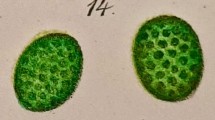Summary
The chloroplasts ofEuglena gracilis have been examined by freeze-cleaving and deep-etching techniques.
The two chloroplast envelope membranes exhibit distinct fracture faces which do not resemble any of the thylakoid fracture faces.
Freeze-cleaved thylakoid membranes reveal four split inner faces. Two of these faces correspond to stacked membrane regions, and two to unstacked regions. Analysis of particle sizes on the exposed faces has revealed certain differences from other chloroplast systems, which are discussed. Thylakoid membranes inEuglena are shown to reveal a constant number of particles per unit area (based on the total particle number for both complementary faces) whether they are stacked or unstacked.
Deep-etchedEuglena thylakoid membranes show two additional faces, which correspond to true inner and outer thylakoid surfaces. Both of these surfaces carry very uniform populations of particles. Those on the external surface (the A surface) are round and possess a diameter of approximately 9.5 nm. Those on the inner surface (the D surface) appear rectangular (as paired subunits) and measure approximately 10 nm in width and 18 nm in length. Distribution counts of particles show that the number of particles per unit area revealed by freeze-cleaving within the thylakoid membrane approximates closely the number of particles exposed on the external thylakoid surface (the A surface) by deep-etching. The possible significance of this correlation is discussed. The distribution of rectangular particles on the inner surface of the thylakoid sac (D surface) seems to be the same in both stacked and unstacked membrane regions. We have found no correlation between the D surface particles and any clearly defined population of particles on internal, freeze-cleaved membrane faces. These and other observations suggest that stacked and unstacked membranes are similar, if not identical in internal structure.
Similar content being viewed by others
References
Arntzen, C. J., R. A. Dilley, andF. L. Crane, 1969: A comparison of chloroplast membrane surfaces visualized by freeze-etch and negative staining techniques; and ultrastructural characterization of membrane fractions obtained from digitonin-treated chloroplasts. J. Cell Biol.43, 16–31.
Ben Shaul, Y., J. A. Schiff, andH. T. Epstein, 1964: Studies of chloroplast development inEuglena. VII. Fine structure of the developing plastid. Plant Physiol.39, 231–240.
Branton, D., 1966: Fracture faces of frozen membranes. Proc. nat. Acad. Sci. (USA.)55, 1048–1056.
—, andR. B. Park, 1967: Subunits in chloroplast lamellae. J. Ultrastruct. Res.19, 283–303.
Epstein, H. T., andJ. A. Schiff, 1961: Studies of chloroplast development inEuglena. 4. Electron and fluorescence microscopy of the proplastid and its development into a mature chloroplast. J. Protozool.8, 427–432.
Frey-Wyssling, A., andE. Steinmann, 1953: Ergebnisse der Feinbauanalyse der Chloroplasten. Vjschr. naturforsch. Ges. Zürich98, 20–29.
Goodenough, U. W., andL. A. Staehelin, 1971: Structural differentiation of stacked and unstacked chloroplast membranes. J. Cell Biol.48, 594–619.
Greenblatt, C. L., andJ. A. Schiff, 1959: A pheophytin-like pigment in dark-adaptedEuglena gracilis. J. Protozool.6, 23–28.
Hall, D. O., H. Edge, andM. Kalina, 1971: The site of ferricyanide photoreduction in the lamellae of isolated spinach chloroplasts: A cytochemical study. J. Cell Sci.9, 289–303.
Hodge, A. J., 1959: Fine structure of lamellar systems as illustrated by chloroplasts. Rev. Mod. Physics31, 331–341.
Holt, S. C., andA. I. Stern, 1970: The effect of 3-(3,4-dichlorophenyl)-l,l-dimethylurea on chloroplast development and maintenance inEuglena gracilis. Plant Physiol.45, 475–483.
Howell, S. H., andE. N. Moudrianakis, 1967 a: Hill reaction site in chloroplast membranes: Non-participation of the quantosome particle in photoreduction. J. molec. Biol.27, 323–333.
— —, 1967 b: Function of the “quantosome” in photosynthesis: Structure and properties. Proc. nat. Acad. Sci. (USA.)58, 1261–1268.
Kahn, A., andD. von Wettstein, 1961: Macromolecular physiology of plastids. II. Structure of isolated spinach chloroplasts. J. Ultrastruct. Res.5, 557–574.
Kannangara, C., D. van Wyk, andW. Menke, 1970: Immunological evidence for the presence of latent Ca++ dependent ATPase and carboxydismutase on the thylakoid surface. Z. Naturforsch.25 b, 613–618.
Klein, S., J. A. Schiff, andA. W. Holowinsky, 1971: Events surrounding the early development ofEuglena chloroplasts. 2. Normal development of fine structure and the consequences of preillumination. Plant Physiol.45, 339–347.
Moor, H., andK. Mühlethaler, 1963: Fine structure in frozen-etched yeast cells. J. Cell Biol.17, 609–628.
Mühlethaler, K., H. Moor, andJ. W. Szarkowski, 1965: The ultrastructure of the chloroplast lamellae. Planta.67, 305–323.
Oda, T., andH. Huzisige, 1965: Macromolecular repeating particles in the chloroplast membrane. Exp. Cell Res.37, 481–484.
Park, R. B., 1965: Substructure of chloroplast lamellae. J. Cell Biol.27, 151–161.
—, andJ. Biggins, 1964: Quantasome: Size and composition. Science (N.Y.)144, 1009–1011.
—, andA. O. Pfeifhofer, 1968: The continued presence of quantasomes in ethylenediaminetetraacetate washed lamellae. Proc. nat. Acad. Sci. (USA.)60, 337–343.
— —, 1969: The effect of ethylene diaminetetraacetate washing on the structure of spinach thylakoids. J. Cell Sci.5, 313–319.
Pinto da Silva, P., andD. Branton, 1970: Membrane splitting in freeze-etching. Covalently bound ferritin as a membrane marker. J. Cell Biol.45, 598–605.
Sane, P. V., D. J. Goodchild, andR. B. Park, 1970: Characterization of chloroplast photosystems 1 and 2 separated by a non-detergent method. Biochim. Biophys. Acta.216, 162–178.
Schwelitz, F. O., R. A. Dilley, andF. L. Crane, 1972: Structural characteristics of a photosynthetic mutant ofEuglena gracilis blocked in photosystem II. Plant Physiol.50, 166–170.
Staehelin, L. A., F. J. Chlapowski, andM. A. Bonneville, 1972: Lumenal plasma membrane of the urinary bladder. J. Cell Biol.53, 73–91.
Tillach, T. W., andV. T. Marchesi, 1970: Demonstration of the outer surface of freezeetched red blood cell membranes. J. Cell Biol.45, 649–653.
Weier, T. E., andA. A. Benson, 1967: The molecular organization of chloroplast membranes. Amer. J. Bot.54, 389–402.
Author information
Authors and Affiliations
Rights and permissions
About this article
Cite this article
Miller, K.R., Staehelin, L.A. Fine structure of the chloroplast membranes ofEuglena gracilis as revealed by freeze-cleaving and deep-etching techniques. Protoplasma 77, 55–78 (1973). https://doi.org/10.1007/BF01287292
Received:
Issue Date:
DOI: https://doi.org/10.1007/BF01287292




